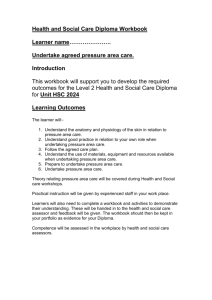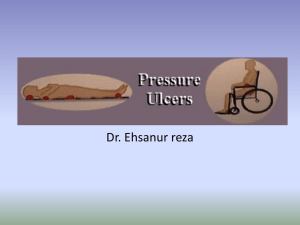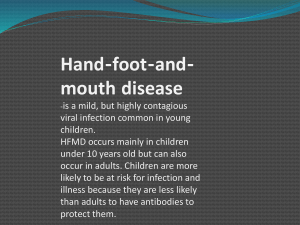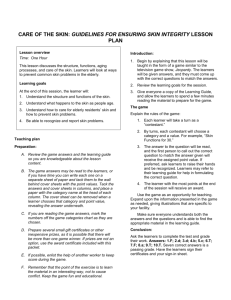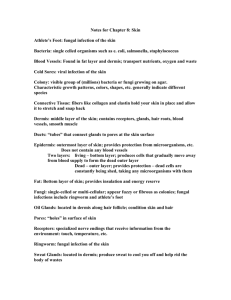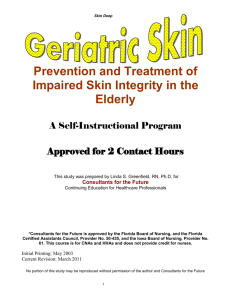PRESSURE SORES
advertisement
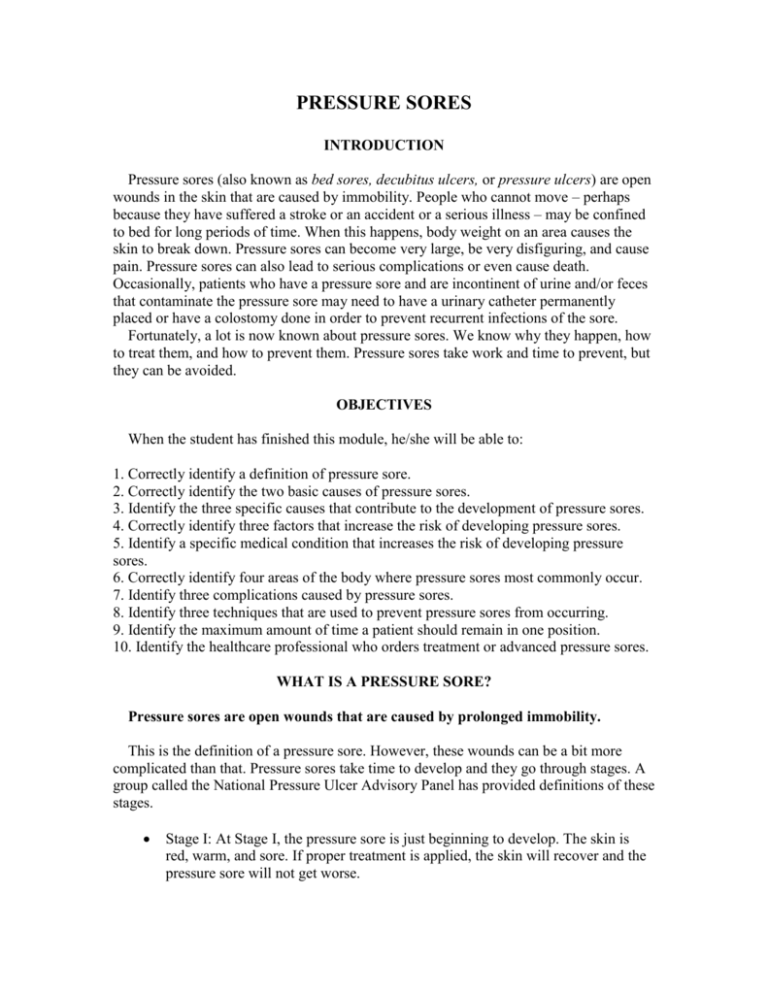
PRESSURE SORES INTRODUCTION Pressure sores (also known as bed sores, decubitus ulcers, or pressure ulcers) are open wounds in the skin that are caused by immobility. People who cannot move – perhaps because they have suffered a stroke or an accident or a serious illness – may be confined to bed for long periods of time. When this happens, body weight on an area causes the skin to break down. Pressure sores can become very large, be very disfiguring, and cause pain. Pressure sores can also lead to serious complications or even cause death. Occasionally, patients who have a pressure sore and are incontinent of urine and/or feces that contaminate the pressure sore may need to have a urinary catheter permanently placed or have a colostomy done in order to prevent recurrent infections of the sore. Fortunately, a lot is now known about pressure sores. We know why they happen, how to treat them, and how to prevent them. Pressure sores take work and time to prevent, but they can be avoided. OBJECTIVES When the student has finished this module, he/she will be able to: 1. Correctly identify a definition of pressure sore. 2. Correctly identify the two basic causes of pressure sores. 3. Identify the three specific causes that contribute to the development of pressure sores. 4. Correctly identify three factors that increase the risk of developing pressure sores. 5. Identify a specific medical condition that increases the risk of developing pressure sores. 6. Correctly identify four areas of the body where pressure sores most commonly occur. 7. Identify three complications caused by pressure sores. 8. Identify three techniques that are used to prevent pressure sores from occurring. 9. Identify the maximum amount of time a patient should remain in one position. 10. Identify the healthcare professional who orders treatment or advanced pressure sores. WHAT IS A PRESSURE SORE? Pressure sores are open wounds that are caused by prolonged immobility. This is the definition of a pressure sore. However, these wounds can be a bit more complicated than that. Pressure sores take time to develop and they go through stages. A group called the National Pressure Ulcer Advisory Panel has provided definitions of these stages. Stage I: At Stage I, the pressure sore is just beginning to develop. The skin is red, warm, and sore. If proper treatment is applied, the skin will recover and the pressure sore will not get worse. Stage II: In Stage II, there is actual breakdown of the skin surface. The pressure sore looks like a blister or an ulcer. However, only the very top layer of skin has been damaged. Stage III: Stage III ulcers involve deeper skin damage. The wound can be very deep. Stage IV: These pressure sores are very serious. The ulcer is very large, the damage may go all the way to the bone, the joints may be affected, and the wound may be infected. So like many medical problems, pressure sores develop, they go through stages. They can also cause significant and irreversible harm: pressure sores and their complications are the direct cause of death in people who are paralyzed from the waist down. However, with relatively simple techniques and conscientious care, pressure sores can be prevented. Fortunately, most pressure sores are Stage I or Stage II and heal without surgical treatment. WHY AND WHERE DO PRESSURE SORES HAPPEN? The human body is made to move. Even when we are sitting still and even when we are sleeping, we move all the time. We toss and turn in bed, we shift positions when we are sitting, we get up and stretch – in ways that are obvious and in ways that are subtle, we are almost always in motion. Prolonged immobility is a very abnormal condition, and not only is prolonged immobility abnormal; it is very bad for the body. If you do not move at all – literally – you are at risk for blood clots, lung infections, damage to your bone and joints, muscle weakness, and many other problems. Pressure sores occur when someone cannot move for a long period of time. The two basic causes of a pressure sore are s decreased blood flow to the tissues and immobility. When there is no blood flow, the tissues will become damaged and die. The patient develops an ulcer – basically a hole – in his/her skin. There are also three processes that are specific causes that contribute to the development of a pressure sore. Pressure: The pressure of someone’s body weight on certain areas of the body is probably the biggest specific cause of pressure sores. F or example, the heels, elbows, the shoulders, and the spine are all bony parts of the body and there is not much skin to pad and protect these areas. So when the body weight is pressing down on these areas, the skin can easily become damaged and a pressure sore can develop. Pressure that can cause a pressure sore can even be caused by wrinkles in the sheets. Friction: When you are sitting or lying down and you change positions, your skin rubs against your clothing, the sheets, etc. This creates friction, and friction can damage skin that is already compromised by pressure and immobility. Imagine taking sandpaper or a nail file and rubbing an area of skin that is weak and sensitive. Shear force: Press the palms of you hands together, apply a moderate amount of pressure, the try and slide one hand down. Doing this creates heat and friction, and this is called the shear effect. The same can occur when someone is on prolonged bedrest: the heat, the friction can be very damaging, and contributes to the development of pressure sores. Pressure sores can happen in many places, but four of the most common are the heels, the hips, the base of the spine, and the elbows. They can also develop on the back of the head, the spine, the shoulders, the hips, and the ears – anywhere there is pressure and not much skin covering the bone. RISK FACTORS FOR DEVELOPING PRESSURE SORES So the basic cause of a pressure sore is decreased blood flow to the area, the specific causes are pressure, friction, and shear, and all of this happens when someone is immobile for a prolonged period of time. There are other factors that contribute to the development of pressure sores, and there are people who are at high risk for developing pressure sores. Age: As we get older, we lose body fat and our skin gets thinner and more fragile and these changes increase the risk of developing bed sores. Malnutrition: Poor nutrition increases the risk of developing pressure sores. Urinary and fecal incontinence: Urine can be irritating to the skin and moisture increases skin breakdown. Fecal matter carries bacteria and this can cause infections if the surface of the skin has been broken. Smoking: Smokers often have poor circulation (nicotine constricts the blood vessels) so they are more prone to having pressure sores. Lack of pain perception: People who have had a stroke or other neurological damage may not have a normal ability to detect pain. They may not realize and can’t tell someone when their skin is irritated or painful or if there is uncomfortable pressure. Medical conditions: Certain medical conditions – especially diabetes – can cause decreased circulation and nerve damage. The skin does not get the blood flow it needs, and if there trauma, injury, or pain, it is not felt because of the nerve damage. These people are very susceptible to developing pressure sores. People who get pressure sores are usually elderly and bedridden, although anyone who is unable to move can get a pressure sore. Those who have had a stroke and suffer from paralysis, people who are heavily sedated (e.g., after an operation or due to a drug overdose), people who cannot move because of trauma: anyone who literally cannot move is at risk for developing a pressure sore. Studies have shown that from 25% to 66% of patients with a spinal cord injury will develop a pressure sore, and even someone who is young and healthy can develop a pressure sore if that person is in surgery (patients are completely immobile during surgery) more than four hours. COMPLICATIONS OF PRESSURE SORES Pressure sores are painful and disfiguring. They can also cause some serious complications. Cellulitis: Cellulitis is an infection of the skin. It is more extensive than a superficial skin infection: the infection penetrates deep past the skin into the fat and muscle. Cellulitis can be very widespread (unlike superficial skin infections). It can involve the entire leg or arm and it cause a lot of pain. Cellulitis is a complication of pressure sores, but cellulites itself can also lead to serious complications such as sepsis. Sepsis: Sepsis is the term for an infection that moves from a local area into the blood stream. When the bacteria enter the bloodstream, they can travel to any area of the body and infect any organ. Sepsis can cause damage to the heart, brain, kidneys, etc. and in elderly patients can often be fatal. Bone and joint infections: Occasionally the infection and tissue damage can get so deep that it reaches into the bones and joints. This can cause permanent loss of bone and the joint may lose the ability to move. PREVENTING PRESSURE SORES Preventing pressure sores will be one of your most important responsibilities when you are caring for someone who cannot move. Preventing pressure sores takes conscientious work, but it is far easier that treating the sores once they have developed. A patient who confined to bed and cannot move should have their skin inspected every day: pay special attention to problem areas. In order to make sure a pressure sore doesn’t happen, you must remember the following: Position changes: This is critical. Patients who are immobile must be moved. They must not be allowed to remain in the same position hour after hour. Most of the time, it is recommended that a patient who cannot move by himself/herself be moved at least every two hours – no longer than that. Some patients may need to be moved more frequently: very often the schedule for position changes will be ordered by a physician or recommended by a physical therapist. The standard routine that is used is left side, back, right side, then repeat. If at all possible, avoid positioning the patient so he/she is lying with the weight on vulnerable areas such as the hip, base of the spine, etc. It is also important to make sure that bony areas with very thin skin cover – the ankles for example – are not touching each other. Dry skin: Skin that is wet can become irritated, and irritation can lead to skin damage and pressure sores. Skin that is wet from urine is especially at risk. Patients who are incontinent of urine or stool should be checked frequently and their skin should be cleaned and dried if it is wet or soiled. Only use a soap that has been approved for use in patients with delicate skin. Padding: There are many, many different ways that padding can be used to prevent pressure sores. Which ones you use will depend on what is available at where you work. When using the various padding tools such as pillows, foam rubber devices, air or water-filled pads, etc., you must remember to keep these clean and dry. They can contribute to the development of a pressure sore if they become wet or contaminated. It is also important to remember to make sure that there are no ridges or sharp edges on these tools that could put pressure on the skin. The same is true for bed linens: these should be free from wrinkles and ridges as much as possible. Special beds filled with air, liquids or silicone bead (much like a water bed) are often used. TREATING PRESSURE SORES When a pressure sore is still at Stage I or Stage II, the preventative measures discussed in the previous section and other forms of treatment discussed here can prevent the pressure sore from progressing to Stage II or Stage IV. But if a pressure sore has reached Stage III or Stage IV, the preventative techniques won’t work. Specific treatment – often surgical treatment – is needed to prevent the pressure sore from becoming permanent, to promote healing, and to prevent complications. These treatments that are used will be ordered by a physician. Taking care of and monitoring the progress of pressure sores is also a sub-specialty of nursing. Many hospitals and health care facilities have a nurse who has special training and certification in the area of wound care. The therapies that are used for a pressure sore will depend on many factors. The following treatments are used for Stage II and Stage IV pressure sores. Debridement: Debridement is a surgical technique. It involves cutting away dead, damaged, and infected tissue, and debridement can be used for pressure sores. It is felt that dead and damaged tissue acts as reservoir for bacteria and if that tissue is not removed, the ulcer will not heal. The tissue can be removed with a scalpel, with a high-pressure liquid, or with salves/creams that dissolve the unwanted tissue. Whirlpool baths and wet dressings can also be used; these loosen the dead tissue so it can more easily be removed. Wound cleaning: Stage III and Stage IV pressure sores need periodic cleaning to remove dead skin and bacteria. If you are responsible for cleaning a pressure sore, only use the solution that has been ordered by the physician. Povidone-iodine and sterile saline solution 0.9% are often used. Wound dressings: Because Stage III and Stage IV pressure sores are open wounds, they need to be covered. Dressings keep the wound clean, prevent infection, and promote healing. Over the years there have been countless attempts to find the best type of wound care and the best type of dressing to treat Stage II and Stage IV pressure sores. Most of the dressings are very specialized. They llow moisture to leave the wound but they air to enter, they protect against infection, they absorb pus, and they help dissolve the dead and infected skin. Again, only use the dressing that has been ordered: it has been designed with that patient’s specific needs. Learning Break: The patient’s physician will decide which solution and dressing will be used for a pressure sore. If you are responsible for using these cleaning solutions and/or applying these dressings, do not make substitutions. Some things like 3% hydrogen peroxide are suitable for simple wound cleaning but make actually be harmful to a pressure sore. Every patient with a Stage III or Stage IV pressure sore should have specific wound care instructions ordered by the physician or a wound care nurse, and you should not deviate from those instructions.

